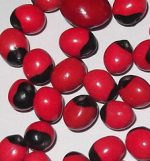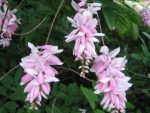
 Rosary pea is an evergreen woody vine native that grows ten to twenty feet long and often climbs over small trees and shrubs. It has a deep root system, slender branches, and two to five inch long leaves that are pinnately compound with five to fifteen pairs of leaflets less than one inch long. The flowers are white to pale pink or violet and carried leaf axils in dense racemes one to three inches long. They give way to flat oblong seed pods that are 1 ½ to 2 inches long and contain three to eight bright red seeds one inch long and with a black spot that has led to another common name, crab’s eye. It is native to warm temperate to tropical regions of India and Asia but has been introduced in Florida as an ornamental and has become invasive in the central and southern parts of the state where it can be found especially in undisturbed pinelands and hammocks. Although the plants are used for medicinal purposes and the seeds are valuable for making jewelry, the latter can be deadly poison if chewed and ingested. USDA Hardiness Zones 9-11
Rosary pea is an evergreen woody vine native that grows ten to twenty feet long and often climbs over small trees and shrubs. It has a deep root system, slender branches, and two to five inch long leaves that are pinnately compound with five to fifteen pairs of leaflets less than one inch long. The flowers are white to pale pink or violet and carried leaf axils in dense racemes one to three inches long. They give way to flat oblong seed pods that are 1 ½ to 2 inches long and contain three to eight bright red seeds one inch long and with a black spot that has led to another common name, crab’s eye. It is native to warm temperate to tropical regions of India and Asia but has been introduced in Florida as an ornamental and has become invasive in the central and southern parts of the state where it can be found especially in undisturbed pinelands and hammocks. Although the plants are used for medicinal purposes and the seeds are valuable for making jewelry, the latter can be deadly poison if chewed and ingested. USDA Hardiness Zones 9-11
The following natives are recommended as alternatives:
Leather Flower (Clematis crispa)
This semi-woody twining vine grows 6-10’ tall and bears solitary, bell-shaped, pale blue to violet blue flowers with white interiors and reflexed petals followed by attractive seed heads. It is native to floodplain forests, marshes and swamps from Virginia to southern Illinois south to Florida and Texas. USDA Hardiness Zones 6-9.
Carolina Jessamine (Gelseminum sempervirens)
Growing up to 20’ long as a vine and 3’ tall as a ground cover, this evergreen twining vine has fragrant bright yellow, funnel-shaped flowers up to 1.5” long from late winter to early spring and shiny, lanceolate, light green leaves. It is native from Virginia to Florida west to Texas where it grows in open woods and thickets and on roadsides. USDA Hardiness Zones 7-10
Photo 1 Credit Shu Suehiro Wikimedia
Photo 2 Credit Yercaud-elango Wikimedia